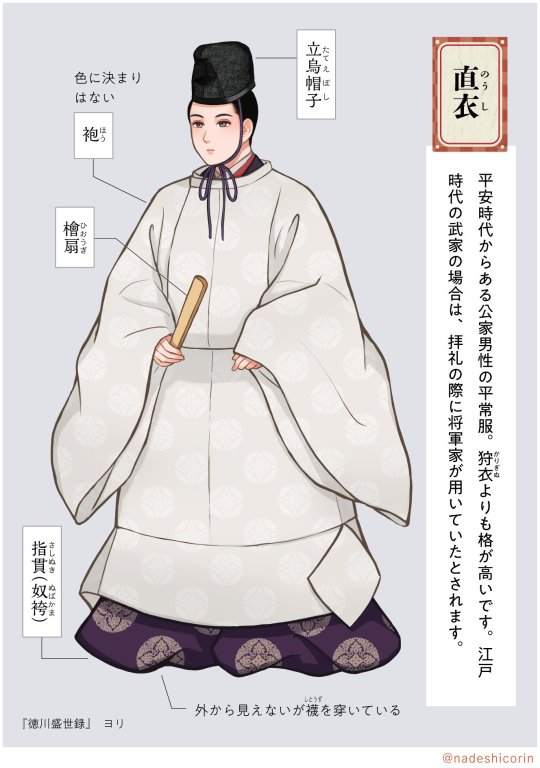#Kazaori-eboshi
Text
Formal outfits for upper ranks samurai & Most formal for lesser ranks samurai - Hitatare, Daimon and Suô court dress,
(as worn by samurai of the Edo period - great charts by Nadeshico Rin). You can find more about samurai ranks and their regulated attires under the tag "samurai kimono".
The Hitatare

直垂 Hitatare first appeared as an attire worn by lower class warriors. As buke (warrior class) rose into status, it was slowy established as a formal garb for samurai during Kamakura period.
In Edo period, hitatare was the most formal attire worn by samurai of the 3rd rank and above. Fabrics used were luxurious, such as 精好織 seigo-ori (a type of textured silk, also used for Shinto priest clothing nowadays).
風折烏帽子 Kazaori-eboshi - black-lacquered hat made of silk, cloth or paper, originally worn by Heian nobility. Many eboshi shapes exist, this one is a upright style (tate-eboshi 立烏帽子) with top folded to the left.
袴 Hakama - formal pants, more exactly 長袴 nagabakama trailing pants
小さ刀 Chîsagatana - a small decorative katana
胸紐 Munahimo - chest ties, first appeared on Heian nobility clothes
菊綴 Kikutoji - decorative tassel-like knots, first appeared on Heian nobility clothes
袖括 Sodekukuri - decorative sleeve ties. Originally appeared on Heian clothings (like kariginu, nôshi, etc) where they were used to tighten sleeve cuffs. Later types like the tiny ones above are purely decorative.
The Daimon

The 大紋 daimon is a specific hitatare set patterned with large 紋 mon (clan/family crests). It was worn by fifth court rank samurai (rank of the daimyô lords for example).
It was put over a 熨斗目 noshime, a type of kosode (=ancestor of the kimono) worn by samurai, with stripes or lattice pattern around waist area.
The Suô

The 素襖 Suô, also a variation of the hitatare, was the ceremonial dress of the lower-ranked samurai. Via explicit permission of the shogunate, some samurai could be granted the right to wear 布衣 hoi (a type of kariginu).
It looked very similar to daimon set, but showed fewer crests of much smaller size. The hat was also different as they wore one called a 侍烏帽子 samurai eboshi.
#japan#fashion#fashion history#samurai kimono#samurai#nadeshico rin#edo era#edo period#buke#warrior class#men kimono#Hitatare#Daimon#Suou#Suo#着物#reference#ressources#Kazaori-eboshi#Hakama#Chîsagatana#Munahimo#Kikutoji#Sodekukuri#noshime#samurai eboshi
242 notes
·
View notes
Text
Other formal outfits of Heian ancestry - Kariginu, Hoi and Nôshi attires
(as worn by samurai of the Edo period - great charts by Nadeshico Rin). You can find more about samurai ranks and their regulated attires under the tag "samurai kimono".
The Kariginu

狩衣 Kariginu first appeared during Heian period where they were informal attires worn by kuge (nobibilty) men for activities such as hunting and 蹴鞠 kemari ball games.
Kariginu rose to formal status during Kamakura period when it started being worn by the buke (warrior class). In Edo period, it was worn by upper-ranked samurai (4th rank and above).
Edo-period kariginu designates a patterned clothing (different from the hoi, see below), often decorated with the family 紋 mon (crest). Colors were not regulated.
風折烏帽子 Kazaori-eboshi - black-lacquered hat made of silk, cloth or paper, originally worn by Heian nobility. Many eboshi shapes exist, this one is a upright style (tate-eboshi 立烏帽子) with top folded to the left.
末広 Suehiro - a type of formal folding fan.
TN: the fan drawn here ressemble more a 中啓 chûkei, as suehiro have curving ribs which don't seems to be the case here (find more about fan types here)
指貫 sashinuki (or 奴袴 nubakama) - large bouffant pants.
Also, note the bare feet! Rin doesn't comment this but this was probably a way to put it below sokutai and ikan (which do have socks)
袖括 Sodekukuri - decorative sleeve ties. Originally appeared on Heian clothings (like kariginu, nôshi, etc) where they were used to tighten sleeve cuffs.
The Hoi

布衣 Hoi is a variation of 狩衣 kariginu (see above).
During Edo period, it was worn by some hatamoto (6th rank samurai) via explicit permission of the shogunate - setting those rewarded by this honor apart from other vassals of the same rank.
Compared to kariginu, hoi were plain solid color.
It is worn here over a 熨斗目 noshime, a samurai kosode (=ancestor of the kimono) with stripes or lattice pattern at waist area.
As for the kariginu, note the bare feet!
The Nôshi

直衣 Nôshi was a type of everyday robes which were first worn by males of the imperial family during Heian era. Formality placed it then above kariginu.
Overtime, their use spread among nobility, and by Edo period, they were a "tad-formal" attire worn by Shogun's family for worship celebrations.
立烏帽子 Tate-eboshi - upright lacquered hat
袍 Hô - round-necked robe with large boxy sleeves
檜扇 hiôgi - formal folding fan made of cypress, also of Heian history. Those were unpatterned as painted ones were for women
指貫 Sashinuki (or 奴袴 nubakama) - large bouffant pants
#japan#fashion#fashion history#samurai kimono#samurai#nadeshico rin#ressources#reference#kariginu#hoi#noshime#hatamoto#buke#warrior class#edo era#edo period#heian period#着物#Kazaori-eboshi#Suehiro#chûkei#sashinuki#nubakama#Sodekukuri#men kimono#Tate-eboshi#Hô#hiôgi#Sashinuki
190 notes
·
View notes